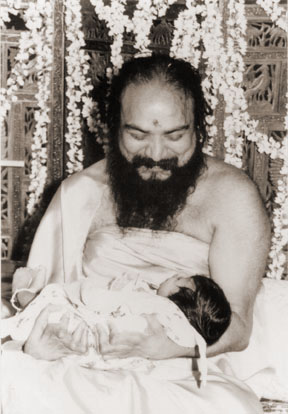HIS LIFE HOME PAGE | PREVIOUS PAGE | NEXT PAGE
Shivabalayogi himself would tell these stories about when he was a child known as Sathyaraju.
Learning not to Fear Ghosts

Sathyaraju ran to his grandfather, Goli Sathyam, and told him what had happened and what the villagers had said. The boy was afraid the dead man would come back to get him. His grandfather reassured the boy and instructed him to return to the graveyard that night to confront his fears. The boy went back and saw the jackals and dogs carrying off the corpse and eating it. He realized he had nothing to fear from that corpse.
Swamiji said that since that time, he was not afraid. He said that most people in India were afraid of ghosts. They would believe a ghost was haunting a particular place, like a tree. However Sathyaraju learned not to be afraid. Instead he would wager that he was not afraid of the ghost. People didn’t believe him and they would accept the bet. Sathyaraju would fearlessly walk up to the haunted tree, then return to collect his winnings.
Standing up in School
Villagers in Adivarapupeta who knew Swamiji as a boy confirm that Sathyaraju was, as Swamiji put it, a naughty boy.
“We used to go to school along with Swamiji. There was a village school, but the children only attended in the afternoon because they had to work to help their elders in the morning. We were in the same class because I was only fifteen days older than Sathyaraju. Do you think we were studying? We would go there with neat slates and keep gossiping, slap each of the students a couple of times, then run home. Swamiji never studied.”
“The teachers were happy that we would run away. He was never interested in studies. We had one teacher who used to sleep during class. This man also used to ask his students to twist rope for him. We had to twist coconut fibers into rope that the teacher used for himself, whether making slings or nets or some other purpose. The teacher used his students for free labor and Swamiji didn’t like it.”
“One day the teacher told Sathyaraju to twist rope. He did it and when he was all finished and the rope was fully twisted and under pressure, he released it and let it unravel. All the coconut fibers knotted into a useless bunch. The teacher shouted at him a lot, but never again did he give him that work to do.”
“One day this teacher was sleeping in class. He wore his hair in a short pigtail. Swamiji sneaked behind him and used some of the rope to tie the pigtail to the chair in which the teacher was dozing. Then he told the other students, ‘If anyone tells the master who did this, I will take care of them.’ ”
“After a while, the teacher got up and started walking and found that the chair was following him. Although no one told him who did it, he knew that only Sathyaraju could have played the prank.”
“The school masters would abuse their positions not only by having the students twist coconut rope, but they would also demand that the students bring them certain things from home like weaving tools or vegetables from the home garden. Those who failed to comply would get beaten with a cane. Even the canes were being supplied by the students. Those students who wanted to be in well with the master would bring him such bribes.”
“Once Swamiji warned the others that from then on, no one was to bring the master any canes. At the time there were three canes around the school and Sathyaraju broke each one and threw away the pieces. Despite his warnings, one student brought a new cane a few days later and the master used it to beat Swamiji. That evening Swamiji roughed up the boy who had brought the cane.”
 “Against”
“Against”
There were some in the village who admired Sathyaraju’s character and hard work, but most didn’t like the outspoken troublemaker. Among his playmates and the village elders, Sathyaraju acquired a reputation for fearlessness, bold outspokenness, and a deeply ingrained sense of fair play and justice. All these qualities combined to make him a natural leader of the boys in his village. But to most of the villagers, he was a naughty boy who got into trouble with almost everyone in the village. The villagers gave him an English nickname, “Against.”
Decades later, Shri Swamiji liked to tell devotees how he was a very naughty boy. He once explained that he never cared about anyone’s feelings. He was only interested in the truth. He was quick to accept a fight with anyone. The only people he got along with were children and the old people of the village.
One example he gave was when the village bhajan group refused to let Sathyaraju join in their singing. Sathyaraju became very upset and argued to be allowed to join. When the villagers continued to refuse, Sathyaraju gathered the village boys and had them make a ruckus outside the place where the bhajans were being sung. The boys started beating sticks, dancing, and making a loud noise to disturb the bhajans. The bhajan group became annoyed and tried to get the boys to be quiet, but Sathyaraju told them only if he was allowed to join the bhajans. The group reluctantly allowed the boy to join them.
Standing up to a Boastful Sadhu
A powerful and respected man of the village had become attached to a sadhu (holy man) whom he later accepted as his guru. This sadhu was a boastful and pompous fellow who threatened dire consequences to anyone who wittingly or unwittingly crossed his path. One of his constantly repeated threats was that he would curse people to turn them into one or another of some low animal species. The simple village folk readily believed these threats so they went about in awe and fear of this angry old man.
Not surprisingly, Sathyaraju took an instant dislike to this sadhu for his arrogant manner and his angry threats. He was convinced in his own mind that the sadhu had none of the powers he boasted of, so he secretly resolved to expose him. One day everyone was sitting in the presence of the sadhu and he was holding forth in his usual boastful manner. Sathyaraju asked him what he would do if someone were to steal any of his things. The sadhu promptly threatened to turn the person into a tiger. Sathyaraju pretended to express awe and wonder but remained quiet. A short while later the sadhu happened to go out. Sathyaraju found himself alone in the sadhu’s room, so he quickly took the sadhu’s bow and arrows and hid them on a ledge just above the place where the sadhu normally slept. He then left the room unnoticed.
When the sadhu returned he noticed that his bow and arrows were missing. Inquiries were made and a search conducted but they could not be found. The sadhu lost his temper and began complaining and yelling about what he would do to the culprit. Sathyaraju, who acted as an interested spectator of the whole scene, suggested in a seemingly innocent tone that the sadhu, by his powers, should be able to locate his missing bow and arrows as well as the culprit. This only enraged the sadhu further and Sathyaraju was quickly hustled away by anxious relatives for fear the sadhu would curse him.
The sadhu’s terrible anger made Sathyaraju somewhat anxious, so he ran to his grandfather and told him in all innocence, “I hid the sadhu’s bow and arrows. If he turns me into a tiger, then the people will hunt me down and kill me, so tie me up inside.” Goli Sathyam could not help being amused. He told the boy not to worry but wait and see what would happen.
Reassured by his grandfather and realizing that some time had already passed yet nothing had happened to him, Sathyaraju became firm in his original conviction that the sadhu was a hoax. He presented himself before the sadhu who was surrounded by his usual gathering of admirers. The boy bravely told him that he had hidden the missing bow and arrows and then showed the sadhu their hiding place. To the astonishment and horror of his relatives, he now challenged the sadhu to transform him into a tiger as he had been threatening to do all along.
The sadhu fretted and cursed but Sathyaraju boldly stood his ground and nothing happened to him. Sathyaraju was soundly reprimanded by the village elder and others for his impertinent behavior but the boy had proved his point. This sadhu never again made such boasts, nor did he ever succeed in terrorizing the villagers again.
Short Changing Disrespect
Swamiji related this story to devotees at the Bangalore ashram a number of times to illustrate his bold intolerance of disrespect.
Sathyaraju went to a market to sell sarees, but he had no buyers that day. The next day he took his sarees to a village called Vella. A landlord’s mother addressed Sathyaraju in a very impolite way, as if she were addressing a servant. She asked if he had any sarees which were seven yards long. The way she addressed him made Sathyaraju angry. He decided to cheat her.
He answered that he had, although all the sarees he had were of the standard six and a half yard length. She called him closer and asked him to measure the length of one saree. To measure the length the sarees are not stretched out but folded in four, measured and then the length is multiplied by four. While doing this Sathyaraju deftly dragged one of the folds to show that the saree length was seven yards. The lady was satisfied and bought a few sarees. The standard rate for a six and a half yard saree at that time was about five rupees, but he charged two extra rupees per saree. All the other ladies who were gathered around her also bought the sarees as the leader had bought them. Sathyaraju could sell all the sarees he brought. As soon as he got paid he ran back to his village lest they discover that they were cheated.

Another of Swamiji’s stories that had him chuckling and the devotees laughing.
The sadhu who threatened to turn people into animals was not the only one confronted by Sathyaraju. The boy’s mother had a guru who enjoyed getting money and material comforts. At one time, Parvatamma left Sathyaraju in charge of the household finances. The sadhu became upset because he was not getting the attention and money to which he was accustomed. The boy sought out his grandfather, Goli Sathyam, for advice. He told the boy that the sadhu was interested only in regaining control over the finances, so the boy did not pay attention to the sadhu. When things did not change the sadhu became angry and complained to Parvatamma, predicting that she would have misfortune if she kept the household finances in Sathyaraju’s control. Parvatamma was anxious to follow her guru’s advice.
As the sadhu was leaving their house, Sathyaraju slipped out and ran ahead to where the sadhu would be passing. The boy rearranged his clothes so he looked like a Harijan (outcaste) and hid in wait for the man. As the sadhu approached the boy reached down to grab something to throw at him. His hand found a broken piece of glass which he threw at the sadhu, hitting him on the forehead and causing a nasty cut.
The sadhu grabbed his bleeding forehead and turned back to return to the house. Meanwhile the boy had rushed back and was already there when the sadhu returned. Sathyaraju acted surprised and asked what had happened. The boy sympathetically cleaned and bandaged the man’s wound. Once the sadhu had been fixed up the boy privately told him, “See what happens when you say bad things about me? Don’t do that again.”



